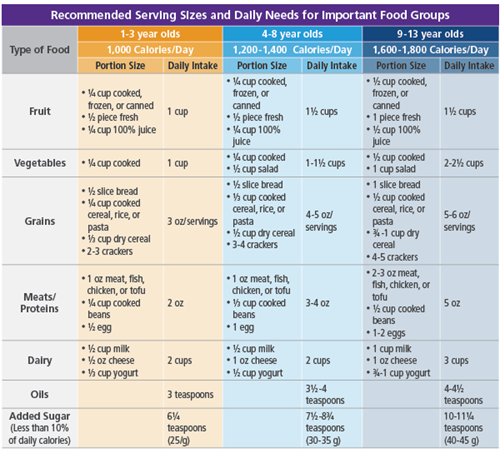
A Pediatrician Explains: How to Build a Balanced Diet for Your Growing Child or Teen
March 29, 2023
Good nutrition is one of the keys to keeping your family healthy – and as your child continues to grow, their dietary needs will change. North Texas pediatrician Dr. Yohanna Andrade, MD explains what you need to know about calories, portion size, and more. 
How do portion size and calorie intake change with age?
The number of calories a child needs will increase as they get older. For example, a toddler typically needs about 1,000 calories per day, while an older child needs between 1,200 and 1,400 calories per day. A teen will need between 1,600 and 1,800 calories per day.
Your child’s daily portion sizes will also get larger as they get older.
- Toddlers:
- Fruit and vegetables: 1 cup.
- Meats and dairy: 2 cups.
- Sugars: 6 teaspoons.
- Grains: 3 ounces/serving.
- Children:
- Fruits and vegetables: 1.5 cups.
- Dairy: 2 cups.
- Meats: 4 to 5 ounces/serving.
- Sugars: 7 to 8 teaspoons.
- Grains: 4 to 5 ounces/serving.
- Teens:
- Fruits: 1.5 cups.
- Vegetables: 2 to 2.5 cups.
- Dairy: 3 cups.
- Sugars: 10 to 11 teaspoons.
- Grains and meats: 5 to 6 ounces/serving.
The chart below is based on information from the Academy of Nutrition and Dietetics and the American Association of Pediatrics. It describes recommended serving sizes and daily needs for important food groups.

For children age 2 to 6, one standard for portions is to start with 1 tablespoon of food for every year of age. (For example, a 2-year-old would get 2 tablespoons of a fruit, vegetable, or protein.) Start with the smaller amount, then watch for signs that they are full – or still hungry.
How are teens’ nutritional needs different from those of younger kids?
Compared to other age groups, teens experience significant growth and development that will have major consequences later in life. Nutrition plays an important role in the timing and pattern of puberty. The onset of puberty triggers a growth spurt and changes body composition and physical activity.
Necessary increases in protein, calcium, iron, nitrogen, zinc, and folate are determined by sexual maturity and growth rate, not age. For example, a 12-year-old boy who plays a competitive sport four to five times a week and has started sexual maturity earlier may need more calories and nutrients than a 14-year-old boy who is not physically active and has a slow growth rate and sexual maturation.
Do teenage boys and girls have different nutritional needs?
Growth in girls happens faster than it does for boys (between 10-12 years of age for girls and about two years later for boys). Increased growth in girls is accompanied by an increase in the proportion of body fat and the onset of menstruation. In comparison, growth spurts in boys are associated with an increase in the proportion of lean mass (muscle) and blood volume. All these affect normal nutritional needs during this critical period.
The chart below lists the recommended amounts of key nutrients for teenage boys and girls. These values stay consistent into adulthood. Click here for more information on which foods are high in these nutrients.
|
|
Males |
Females |
|
Daily Caloric intake |
2,000 to 3,000 cal/d |
1,800 to 2,400 cal/d |
|
Iron |
0.57 mg/d |
0.23 mg/d |
|
Calcium |
210 mg/d |
110 mg/d |
|
Magnesium |
4.4 mg/d |
2.3 mg/d |
|
Zinc |
0.27 mg/d |
0.18 mg/d |
|
Nitrogen |
320 mg/d |
160 mg/d |
Why is healthy eating so important for teens’ physical and mental health?
Good nutrition plays an important role that goes beyond the growth of muscle and bone. A diet that lacks essential nutrients or calories can directly affect heart and lung health, brain development, and immunity.
Children who have poor eating habits or nutritional deficits as teens can experience long-term consequences. These include loss of final adult height, osteoporosis, irregular menstrual periods, and delayed puberty as well as cognitive impairment, declining academic performance, and emotional well-being.
Physical activity levels increase for many children as they become teens. This means that they will need to increase the number of calories they consume to get the energy they need. Insufficient food intake in a physically active teen can lead to reduced growth, a drop in metabolism and, for girls, even the absence of menstruation. Habits developed during this time – good or bad – will impact your teen as an adult.
What are some easy ways to get more nutrients into a child or teen’s diet?
- Eat more meals at home. Restaurants tend to use more oil and refined sugar – and more preservatives and chemicals – in their food. This can make food look or taste better, but also be less healthy. When you cook at home, choose better ingredients and healthy ways to cook (like grilling, boiling, or steaming instead of frying).
- When shopping for groceries, take your child with you. They can help you choose fresh produce when possible, instead of canned, bagged, or even frozen foods. The more colorful veggies, fruits, and grains you buy, the better balance of nutrients you will have.
- Keep healthy snacks at home. This could include things like fruit, yogurt, granola bars, and peanut butter. Avoid candy, ice cream, chips, and sugary cereal.
- Make your child’s plate appealing. When their plate has a variety of different colors, shapes, and textures, they will be more likely to eat what’s in front of them.
- Imitation is key. When it comes to good nutrition, your children will learn from your example. As much as possible, all family members should eat their meals together, and parents should eat the same foods as their child or teen.
Use the MyPlate guidelines to make sure your child is eating the right portions of certain foods.
============
Do you need insurance for yourself and your children?
Texas STAR Medicaid and CHIP provide healthcare for low-income families, children, and pregnant women at low or no cost.



